I declare that sharpening is important. Even a new tool needs honing. An old tool may need surgery.
A sharp tool is easier to push through wood and achieve that precise cut you need for a dovetail joint, mortise, or that crucial 1/32″ fitting adjustment. It reduces the tendency to slip and cut flesh – your flesh. Be careful; a sharp edge tool loves to bite the hand that holds it!
A sharp edge is all that counts
Oilstones, water stones, and diamond stones coexist in the woodworking world. These are most used by woodworkers to sharpen chisels, axe bits, and plane blades. In a pinch, sandpaper, bricks and concrete sidewalks have been used.
Once someone finds a technique or system that is convenient to them, they don’t mind sharpening. The result is even better – a sharp tool with a crisp edge and shiny bevel.
Many stick with it until a new method trends on the woodworking grapevine.
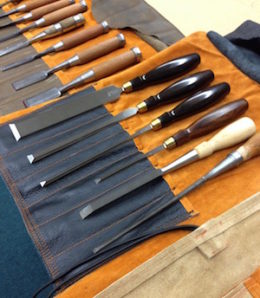
Oil
Oilstones are a traditional choice for many woodworkers. The classic line of Arkansas stones mined in the U.S. are desired all over the world. Ancient sources of native stones still exist on other parts of the planet including Japan and the Middle East.
Black, white, gray, and other colorful abrasive grades ranging from soft (coarse) to hard (very fine) are classified according to their sharpening properties.
Usually, the stones are used with oil, or even spit, on the surface to enable the tool to glide over the stone and fix itself with an even edge. Truth be told, a lubricant is not even necessary on the stones. Oilstones cut (sharpen) metal slower than other methods. They are hard as granite (wait! they are granite) and last forever.
Often times the stones are passed down through generations. If you are lucky, you can find old, used stones in great condition. Don’t overlook old tool boxes, antique stores and flea markets.
Rare stones and NOS (new old stones) in beautifully crafted stone holders may come within reach. If you see one, grab it. A little conditioning or cleaning and they are ready to go to the bench.
Water
Natural stone mining has been a human activity for thousands of years. Water stones are still a traditional choice for woodworkers all over the world.
Nature created the stones by grinding, crushing and compressing layers of sediment material. This has been going on for millennia. Today, some mountain sources have been closed to further mining. This makes existing supplies of large, uncut mined stone blocks precious and rare.
Generally, water stones must be primed or soaked in water for much of their life. The sharpening mud or swarf doesn’t have a chance!
Storage and soaking create a problem for people who work in cold climates. The stones are susceptible to fissuring, cracking, freezing, and breaking.
Unpredictable changes like sloughing of an unevenly formed natural stone can also occur.
Contrary to popular thought, oil can be used on the stones.
The water stone category features a number of companies that offer many choices and qualities of stones.
Ceramic Water stones
Man-made ceramic water stones hit the scene and became popular. These stones are made from blending and compressing uniform ceramic particles with binding material. As a result, the stone is dense and the particles are distributed evenly. The resulting composite may or may not be backed by a layer of glass.
This is the splash and go system that only requires a spritz of water on the stone before and during sharpening.
You have to be aware of the potential for cracking from uneven drying, freezing water, or just being knocked around. Man-made stones are not exempt from the possibility of damage.
Nothing is perfect.
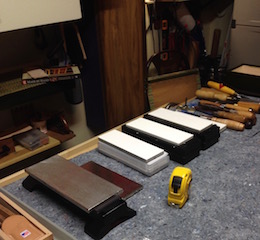
The potential to “dish” or lose its flat surface can be a problem with water stones. Inconsistent, noticeable patterns of wear appear on the surface of the stone. The stone must be reconditioned and flattened with a metal reference plate to get it back flat.
The flattening plate is expensive. There are other inexpensive, innovative ways to flatten a stone, such as using sandpaper on a flat granite tile or even another stone.
What I Use
Personally, I use glass-backed ceramic water stones and love the system. The swarf generated from the smoother surface seems to help the stone cut faster. When done, the swarf is easily rinsed away.
I schedule “play dates” to sharpen and tune all my tools. The exercise is relaxing and quiets the hubbub of life in the shop. I get to slow down and indulge in a little sharpening zen.
I respect and take care of my tools and stones. Such care, however, can be a pain for people who feel that sharpening tools, flattening and maintaining stones is something to get out of the way as quickly as possible.

Grits
Both regular water stones and ceramic water stones come in a range of abrasive qualities or grits. These are used in graduated steps to reach the level of sharpness and polish desired. That can be an investment, too.
The concept of graduated grits:
- coarse (to correct an edge)
- medium (to refine)
- fine (to hone and polish),
is a reliable path to achieve and maintain sharpness with water stones as well as any other method.
Through personal preference, each woodworker decides how many grits they will use to achieve their sharpness goals.
Ceramic stones
Modern processes have produced ceramic stones which are not the same as ceramic water stones. They are made from a fused block of ceramic material which is durable, long lasting, and does not require flattening. Performing like oil stones, they cut slower. These can be used dry, without oil or water. The mess and setup for sharpening is avoided.
Diamonds
Currently, some woodworkers have switched allegiance to diamond stones. These are metal plates fused with industrial diamond bits that sharpen edge tools without the fussiness of oil and sometimes even water.
Some users throw a bit of water on the stone (old habits, perhaps) to help the tool glide over the plate. A small set-up close to the bench is all you need.
An advantage is that these stones don’t suffer from dishing. Less maintenance of the stone is required. The embedded diamond coating does eventually shed, however. The speed of deterioration depends on how aggressive the sharpening is.
Diamond stones can be set up in a coarse, medium, and fine system, but it’s not as varied as water stones.
They can be problematic, too. Care must be taken to keep the plate from rusting.
Leather: sharpening versus polishing
Strops are used to extend working time on an edge. Experienced woodworkers, notably carvers, claim that they can put off sharpening for an entire project using only a strop.
The use of the leather strop to polish a sharpened blade surface is a subject of debate as to its necessity. Unintentional rounding of the edge on the relatively soft leather surface seems to be the biggest argument against it. Is it a lazy way to avoid sharpening in the moment? No. I’m just not good at it.
I have used leather to strop chisels before the chisel edge became noticeably worn. If it is too far gone, I go to the stone for an ad hoc sharpening session.
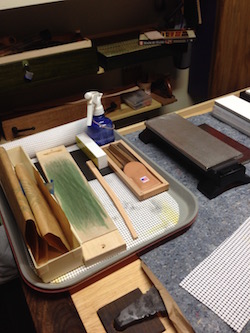
Wheels: sharpening with a twist
Old school hand cranked bench grinders are still viable options. They are perfect for the mostly all hand tool workshop. No longer made, they can be found on the antique shop-flea market circuit. Find one in good shape, clean it up and use it.
In less than a minute, I can set the grinder on the bench and sharpen my tools.
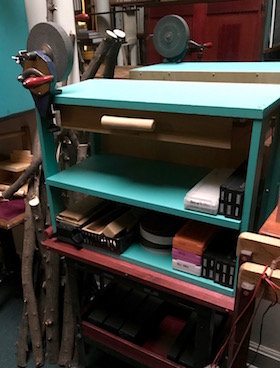
Many woodworkers use electric bench grinding set ups that are fast and expedient. While sharpening, care must be taken to avoid overheating, and thereby, weakening the metal.
All the sharpening systems have their plusses and minuses. Budget, climate, storage and the effort you take maintaining your stones are factors that will influence your choice.
Sharpening angles
Sharpening has evolved from its utilitarian roots into a science. Considering the math and science of angles, bevels, burrs, and projections, it can be intimidating for most people.
Maintaining a slanted bevel, consistently and cleanly, is just one more thing to keep in mind when sharpening.
A consistent bevel angle can be obtained and maintained:
- manually by placing the bevel, unaided on the sharpening surface and dragging the tool across,
- by using a sharpening or honing guide with wheels and angle adjustment lines,
- by using a bench grinder; an electric one is most effective.
Just Choose A Method to Start Sharpening
Notice how just about everything is up for debate? If it’s up for debate, then it’s up to you. Your tools. Your rules.
You don’t have to sharpen at all.
Yeah, you do.
This is what I know:
- a sharp tool is safe and efficient,
- sharpening is a chore and inconvenience,
- people who don’t know how to sharpen tools properly… don’t.
At a time in the not too distant past, I did not know.
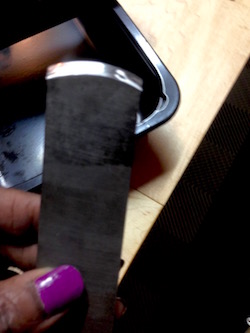
I tried many methods and got better over time. That is the real goal.
-Shirley J
💚

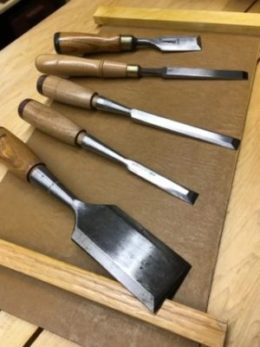
4 thoughts on “● Different Paths to Sharp”
Shirley,
I find your blog refreshing and encouraging. As a professional woodworker and teacher of 30 years, You express the same attitude that I try to instill in my students. Success comes with practice , take your time and enjoy the process.
Thanks so much Michael. I write for them as well as myself.
Very good, it seems to me that you have perfected tool sharpening.
Well, practice makes perfect but not everything’s…perfect. That is in the eyes of the beholder! Thanks for reading.
Comments are closed.